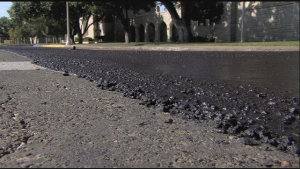Asphalt Microsurfacing
Asphalt Microsurfacing Tampa
Microsurfacing
 Microsufacing is similar to slurry seal. It consists of the application of a mixture of water, asphalt emulsion, aggregate (very small crushed rock), and chemical additives to an existing asphalt concrete pavement surface. Polymer is commonly added to the asphalt emulsion to provide better mixture properties. The major difference between slurry seal and microsurfacing is in how they “break” or harden. Slurry relies on evaporation of the water in the asphalt emulsion. The asphalt emulsion used in microsurfacing contains chemical additives which allow it to break without relying on the sun or heat for evaporation to occur. Thus, microsurfacing is an application that hardens quicker than slurry seals and can be used when conditions would not allow slurry seal to be successfully placed. Streets that have a lot of shade and streets that have a lot of traffic are good candidates for microsurfacing.
Microsufacing is similar to slurry seal. It consists of the application of a mixture of water, asphalt emulsion, aggregate (very small crushed rock), and chemical additives to an existing asphalt concrete pavement surface. Polymer is commonly added to the asphalt emulsion to provide better mixture properties. The major difference between slurry seal and microsurfacing is in how they “break” or harden. Slurry relies on evaporation of the water in the asphalt emulsion. The asphalt emulsion used in microsurfacing contains chemical additives which allow it to break without relying on the sun or heat for evaporation to occur. Thus, microsurfacing is an application that hardens quicker than slurry seals and can be used when conditions would not allow slurry seal to be successfully placed. Streets that have a lot of shade and streets that have a lot of traffic are good candidates for microsurfacing.
Why? Microsurfacing is applied in order to help preserve and protect the underlying pavement structure and provide a new driving surface. Roads chosen for microsurfacing application generally have low to moderate distress and narrow crack width.
Microsurfacing Benifets
Microsurfacing will also correct moderate to severe raveling by sealing and filling voids in the existing surface. However, the addition of better quality aggregate, emulsifiers and fast-setting chemicals makes for a more durable skid resistant surface that’s traffic-ready in less than 1 hour. When applied, it also has a dark brown color but quickly blackens as the water is chemically ejected during the curing process. Because of the fast cure time and type of equipment used, microsurfacing is typically recommended for roadways, airport runways and open parking lots (void of landscape islands, covered awnings, etc.) where the equipment has room to stop and start without crossing over previously applied material.
